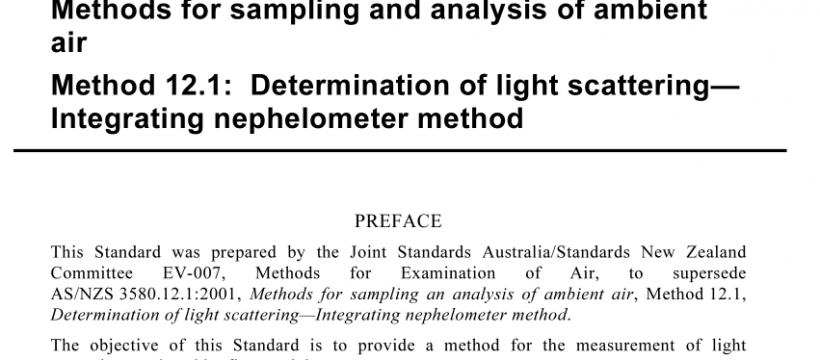AS NZS 3580.12.1:2015 pdf free download
AS NZS 3580.12.1:2015 pdf free download.Methods for sampling and analysis of ambient air
5.1 Integrating nephelometer
The integrating nephelometer is a continuous direct-reading instrument that measures the light-scattering coefficient of a sample of air and shall meet or exceed the specifications given in Table 1. The sample is drawn through a light-proof housing where it is illuminated by a diffuse visible light source and the intensity of the scattered light is measured. The response is sensitive to the spectral characteristics of the instrument. Suitable instruments have a spectral response centred at 500 ±50 nm. As light scattering is a function of the scattering angle the internal optical geometry of the instrument is arranged so that the response of the detector is proportional to the light scattering integrated over all scattering angles. In practice, physical limitations dictate that the integration angle is from approximately 10° to approximately 170°. The principal features of a nephelometer are shown in Figure 1.
The integrating nephelometer shall include a sample inlet, sample conditioner, relative humidity sensor and temperature sensor. The nephelometer shall be capable of ensuring that the relative humidity of air sampled is not greater than 60% measured at a point representative of the air in the scattering chamber. The temperature of the air sample measured at a point representative of the air in the scattering chamber shall be maintained at not more than 25°C above ambient temperature.
NOTE: The readings obtained using a nephelometer depends on its internal optical geometry, the spectral characteristics of the light source and the spectral response of the light sensor. Hence the readings obtained using different nephelometers are not comparable unless they are of equivalent optical geometry and spectral characteristics.
5.5 Particulate filter
A filter shall be used for removing particles from zero air, calibration and precision check gases and shall have a specified collection efficiency of at least 99.9% for particles of 0.3 μm equivalent aerodynamic diameter.
NOTE: A 1.0 µm PTFE filter has been found to be satisfactory. HEPA cartridge filters would also be suitable.
AS NZS 3580.12.1:2015 pdf free download
